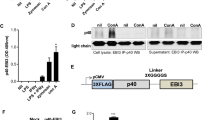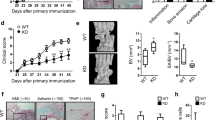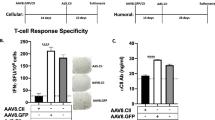Abstract
Tumor necrosis factor (TNF) is a proinflammatory cytokine involved in the pathogenesis of rheumatoid arthritis, and antagonism of TNF may reduce the activity of the disease. Among a number of techniques for gene transfer in vivo, the direct injection of plasmid DNA into muscle is simple, inexpensive, and safe. In this study, we attempted to treat collagen-induced arthritis (CIA) with anti-TNF gene therapy by transferring the plasmid encoding soluble p75 TNF receptor linked to the Fc portion of human IgG1 (sTNFR:Fc) using in vivo electroporation. DBA/1 mice were immunized with bovine type II collagen and boosted with the same antigen. At 2 days after boosting, the plasmid vector containing cDNA for the sTNFR:Fc was injected into one selected site in the gastrocnemius muscle followed by electroporation. Serum levels of sTNFR:Fc reached 2.3 ng/ml on day 5 when gene expression reached its peak. Macroscopic analysis of paws for redness, swelling and deformities showed that the onset of moderate-to-severe CIA in mice treated with sTNFR:Fc was prevented on a significant level compared with the control mice (P<0.05). The beneficial effect of sTNFR:Fc DNA transfer lasted for at least 18 days following treatment. In addition, both the synovitis and the erosion of cartilage in the knee joints were dramatically reduced in mice treated with sTNFR:Fc (P<0.05). The expression of IL-1β and IL-12 in the paw was also decreased by sTNFR:Fc treatment (P<0.01) while there was little change in the levels of IL-17 and vWF. These data showed that sTNFR:Fc expression plasmid was effective in the prevention of CIA, and in vivo electroporation-mediated gene transfer may provide a new approach to cytokine therapy in autoimmune arthritis.
This is a preview of subscription content, access via your institution
Access options
Subscribe to this journal
Receive 12 print issues and online access
$259.00 per year
only $21.58 per issue
Buy this article
- Purchase on Springer Link
- Instant access to full article PDF
Prices may be subject to local taxes which are calculated during checkout







Similar content being viewed by others
References
Kaklamanis PM . Experimental animal models resembling rheumatoid arthritis. Clin Rheumatol 1992; 11: 41–47.
Deleuran BW et al. Localization of tumor necrosis factor receptors in the synovial tissue and cartilage-pannus junction in patients with rheumatoid arthritis. Implications for local actions of tumor necrosis factor alpha. Arthritis Rheum 1992; 35: 1170–1178.
Arend WP, Dayer JM . Inhibition of the production and effects of interleukin-1 and tumor necrosis factor alpha in rheumatoid arthritis. Arthritis Rheum 1995; 38: 151–160.
Brennan FM, Feldmann M . Cytokines in autoimmunity. Curr Opin Immunol 1992; 4: 754–759.
Thorbecke GJ et al. Involvement of endogenous tumor necrosis factor alpha and transforming growth factor beta during induction of collagen type II arthritis in mice. Proc Natl Acad Sci USA 1992; 89: 7375–7379.
Joosten LA, Helsen MM, van de Loo FA, van den Berg WB . Anticytokine treatment of established type II collagen-induced arthritis in DBA/1 mice A comparative study using anti-TNF alpha, anti- IL-1 alpha/beta, and IL-1Ra. Arthritis Rheum 1996; 39: 797–809.
Chu CQ, Field M, Feldmann M, Maini RN . Localization of tumor necrosis factor alpha in synovial tissues and at the cartilage–pannus junction in patients with rheumatoid arthritis. Arthritis Rheum 1991; 34: 1125–1132.
Saxne T et al. Detection of tumor necrosis factor alpha but not tumor necrosis factor beta in rheumatoid arthritis synovial fluid and serum. Arthritis Rheum 1988; 31: 1041–1045.
Beckham JC et al. Disease severity in rheumatoid arthritis: relationships of plasma tumor necrosis factor-alpha, soluble interleukin 2-receptor, soluble CD4/CD8 ratio neopterin and fibrin D-dimer to traditional severity and functional measures. J Clin Immunol 1992; 12: 353–361.
Smith CA et al. A receptor for tumor necrosis factor defines an unusual family of cellular and viral proteins. Science 1990; 248: 1019–1023.
Loetscher H et al. Molecular cloning and expression of the human 55 kd tumor necrosis factor receptor. Cell 1990; 61: 351–359.
Engelmann H et al. A tumor necrosis factor-binding protein purified to homogeneity from human urine protects cells from tumor necrosis factor toxicity. J Biol Chem 1989; 264: 11974–11980.
Olsson I et al. Isolation and characterization of a tumor necrosis factor binding protein from urine. Eur J Haematol 1989; 42: 270–275.
Mohler KM et al. Soluble tumor necrosis factor (TNF) receptors are effective therapeutic agents in lethal endotoxemia and function simultaneously as both TNF carriers and TNF antagonists. J Immunol 1993; 151: 1548–1561.
Evans TJ et al. Protective effect of 55- but not 75-kD soluble tumor necrosis factor receptor–immunoglobulin G fusion proteins in an animal model of gram-negative sepsis. J Exp Med 1994; 180: 2173–2179.
Wooley PH, Dutcher J, Widmer MB, Gillis S . Influence of a recombinant human soluble tumor necrosis factor receptor FC fusion protein on type II collagen-induced arthritis in mice. J Immunol 1993; 151: 6602–6607.
Moreland LW et al. Treatment of rheumatoid arthritis with a recombinant human tumor necrosis factor receptor (p75)-Fc fusion protein. N Engl J Med 1997; 337: 141–147.
Hasler F et al. Chronic TNF neutralization (up to 1 year) by lenercept (TNFR 55 IgG1, Ro 45-2081) in patients with rheumatoid arthritis: results from open label extension of a double blind single-dose phase I study. Arthritis Rheum 1996; 39S: 2:43.
Ghivizzani SC et al. Direct adenovirus-mediated gene transfer of interleukin 1 and tumor necrosis factor alpha soluble receptors to rabbit knees with experimental arthritis has local and distal anti-arthritic effects. Proc Natl Acad Sci USA 1998; 95: 4613–4618.
Mageed RA et al. Prevention of collagen-induced arthritis by gene delivery of soluble p75 tumour necrosis factor receptor. Gene Therapy 1998; 5: 1584–1592.
Le CH, Nicolson AG, Morales A, Sewell KL . Suppression of collagen-induced arthritis through adenovirus-mediated transfer of a modified tumor necrosis factor alpha receptor gene. Arthritis Rheum 1997; 40: 1662–1669.
Quattrocchi E et al. Paradoxical effects of adenovirus-mediated blockade of TNF activity in murine collagen-induced arthritis. J Immunol 1999; 163: 1000–1009.
Nishikawa M, Huang L . Nonviral vectors in the new millennium: delivery barriers in gene transfer. Hum Gene Ther 2001; 12: 861–870.
Rizzuto G et al. Efficient and regulated erythropoietin production by naked DNA injection and muscle electroporation. Proc Natl Acad Sci USA 1999; 96: 6417–6422.
Mir LM et al. High-efficiency gene transfer into skeletal muscle mediated by electric pulses. Proc Natl Acad Sci USA 1999; 96: 4262–4267.
Lee Y et al. Improved expression of vascular endothelial growth factor by naked DNA in mouse skeletal muscles: implication for gene therapy of ischemic diseases. Biochem Biophys Res Commun 2000; 272: 230–235.
Lim BK et al. Local expression of interleukin-1 receptor antagonist by plasmid DNA improves mortality and decreases myocardial inflammation in experimental coxsackieviral myocarditis. Circulation 2002; 105: 1278–1281.
Ahmadzadeh N, Shingu M, Nobunaga M . The effect of recombinant tumor necrosis factor-alpha on superoxide and metalloproteinase production by synovial cells and chondrocytes. Clin Exp Rheumatol 1990; 8: 387–391.
Shingu M et al. The effects of cytokines on metalloproteinase inhibitors (TIMP) and collagenase production by human chondrocytes and TIMP production by synovial cells and endothelial cells. Clin Exp Immunol 1993; 94: 145–149.
Moser R, Schleiffenbaum B, Groscurth P, Fehr J . Interleukin 1 and tumor necrosis factor stimulate human vascular endothelial cells to promote transendothelial neutrophil passage. J Clin Invest 1989; 83: 444–455.
Nawroth PP et al. Tumor necrosis factor/cachectin interacts with endothelial cell receptors to induce release of interleukin 1. J Exp Med 1986; 163: 1363–1375.
Peppel K, Crawford D, Beutler B . A tumor necrosis factor (TNF) receptor-IgG heavy chain chimeric protein as a bivalent antagonist of TNF activity. J Exp Med 1991; 174: 1483–1489.
Dayer JM . The saga of the discovery of IL-1 and TNF and their specific inhibitors in the pathogenesis and treatment of rheumatoid arthritis. Joint Bone Spine 2002; 69: 123–132.
Arner EC, Pratta MA . Independent effects of interleukin-1 on proteoglycan breakdown, proteoglycan synthesis, and prostaglandin E2 release from cartilage in organ culture. Arthritis Rheum 1989; 32: 288–297.
Joosten LA, Lubberts E, Helsen MM, van den Berg WB . Dual role of IL-12 in early and late stages of murine collagen type II arthritis. J Immunol 1997; 159: 4094–4102.
Malfait AM et al. Blockade of IL-12 during the induction of collagen-induced arthritis (CIA) markedly attenuates the severity of the arthritis. Clin Exp Immunol 1998; 111: 377–383.
Triantaphyllopoulos KA, Williams RO, Tailor H, Chernajovsky Y . Amelioration of collagen-induced arthritis and suppression of interferon-gamma, interleukin-12, and tumor necrosis factor alpha production by interferon-beta gene therapy. Arthritis Rheum 1999; 42: 90–99.
Moreland LW et al. Recombinant soluble tumor necrosis factor receptor (p80) fusion protein: toxicity and dose finding trial in refractory rheumatoid arthritis. J Rheumatol 1996; 23: 1849–1855.
Drabick JJ, Glasspool-Malone J, King A, Malone RW . Cutaneous transfection and immune responses to intradermal nucleic acid vaccination are significantly enhanced by in vivo electropermeabilization. Mol Ther 2001; 3: 249–255.
Glasspool-Malone J, Somiari S, Drabick JJ, Malone RW . Efficient nonviral cutaneous transfection. Mol Ther 2000; 2: 140–146.
Kim SH et al. Ex vivo gene delivery of IL-1Ra and soluble TNF receptor confers a distal synergistic therapeutic effect in antigen-induced arthritis. Mol Ther 2002; 6: 591–600.
Mennuni C et al. Hyaluronidase increases electrogene transfer efficiency in skeletal muscle. Hum Gene Ther 2002; 13: 355–365.
Kim JM et al. Angiostatin gene transfer as an effective treatment strategy in murine collagen-induced arthritis. Arthritis Rheum 2002; 46: 793–801.
Kim SH et al. Effective treatment of established murine collagen-induced arthritis by systemic administration of dendritic cells genetically modified to express IL-4. J Immunol 2001; 166: 3499–3505.
Bessis N et al. Syngeneic fibroblasts transfected with a plasmid encoding interleukin-4 as non-viral vectors for anti-inflammatory gene therapy in collagen- induced arthritis. J Gene Med 2002; 4: 300–307.
Lubberts E et al. Adenoviral vector-mediated overexpression of IL-4 in the knee joint of mice with collagen-induced arthritis prevents cartilage destruction. J Immunol 1999; 163: 4546–4556.
Acknowledgements
This work was supported by grants from the Korean Ministry of Health and Welfare (Grant No. 02-PJ1-PG10-20501-0001).
Author information
Authors and Affiliations
Rights and permissions
About this article
Cite this article
Kim, JM., Ho, SH., Hahn, W. et al. Electro-gene therapy of collagen-induced arthritis by using an expression plasmid for the soluble p75 tumor necrosis factor receptor-Fc fusion protein. Gene Ther 10, 1216–1224 (2003). https://doi.org/10.1038/sj.gt.3301985
Received:
Accepted:
Published:
Issue Date:
DOI: https://doi.org/10.1038/sj.gt.3301985
Keywords
This article is cited by
-
A New Strategy to Deliver Synthetic Protein Drugs: Self-reproducible Biologics Using Minicircles
Scientific Reports (2014)
-
Lentiviral vector-mediated stable expression of sTNFR-Fc in human macrophage and neuronal cells as a potential therapy for neuroAIDS
Journal of Neuroinflammation (2011)
-
IL-17 increased the production of vascular endothelial growth factor in rheumatoid arthritis synoviocytes
Clinical Rheumatology (2006)
-
VeloceGenomics: An Accelerated in Vivo Drug Discovery Approach to Rapidly Predict the Biologic, Drug-Like Activity of Compounds, Proteins, or Genes
Pharmaceutical Research (2005)
-
DNA electrotransfer: its principles and an updated review of its therapeutic applications
Gene Therapy (2004)



